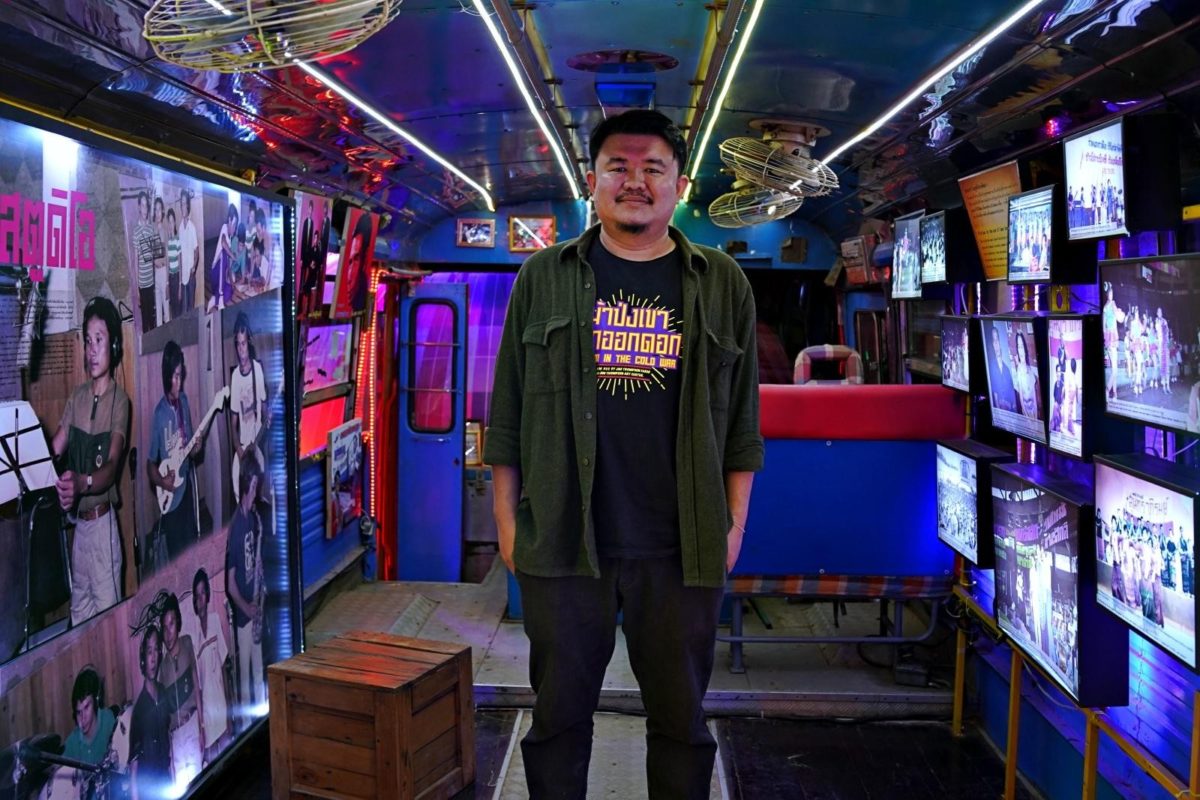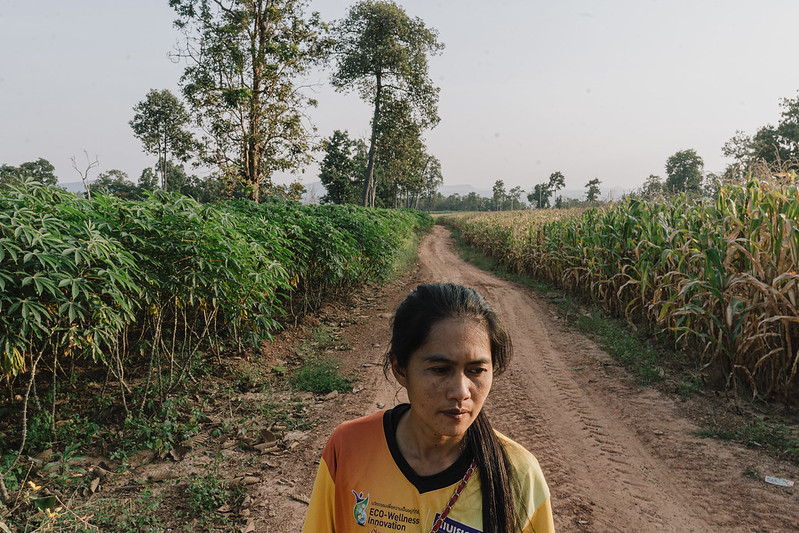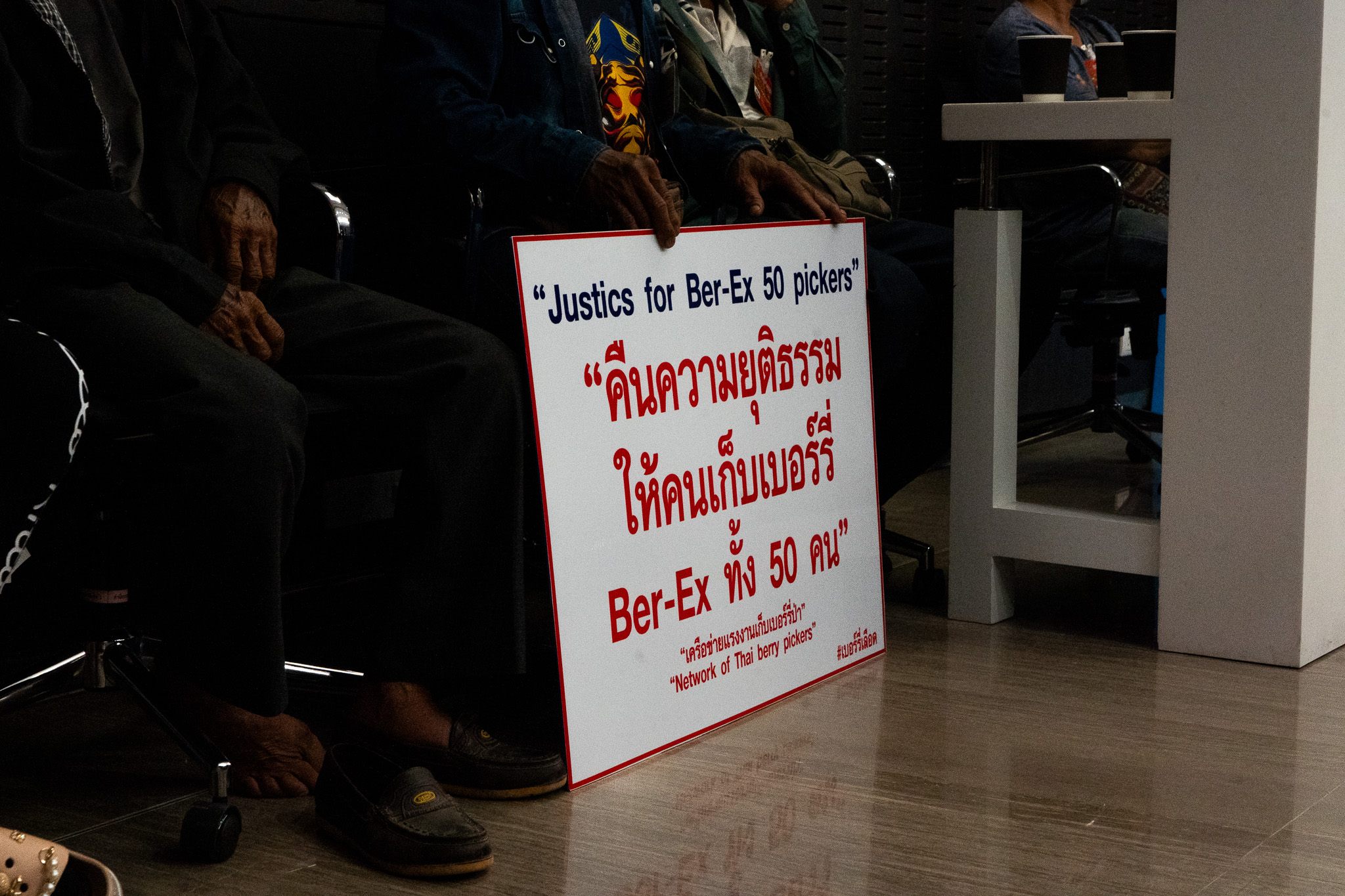
Arthit “Fai” Mulsarn is known as a painter, chef and owner of Bangkok’s independent bookstore Book in the Otherness, a place where book lovers, critics, and thinkers gather to eat beef lap, drink craft beer, and discuss literature, culture, and politics.
But Fai is also an expert on cultural studies whose interest in molam earned him a master’s degree from Mahidol University’s Research Institute for Languages and Cultures of Asia. A native of Yasothon province, Fai studied how people in Isaan during the Cold War era used molam against suppression by the state and to communicate their grievances.
Fai manages the Molam Mobile Bus Project at the Jim Thompson Art Center, a mobile exhibition project that travels across the country to collect and display molam traditions.
The Isaan Record’s Yodsapon Kerviboon caught up with Fai as he was setting up the first molam bus exhibition at an event at a local school in Pratai district in Nakhon Ratchasima last November.

Arthit “Fai” Mulsarn is the manager of the Molam Mobile Bus Project exhibition at the Jim Thompson Art Center.
The Isaan Record (IR): How did the Molam Mobile Bus Project exhibition come about?
Arthit Mulsarn (AM): Our team worked on the project under the Jim Thompson Art Center together with the Jim Thompson Farm, so the project belongs to Jim Thompson. In the beginning, Jim Thompson sold Isaan silk and then came the Jim Thompson Farm that has displayed and preserved an Isaan village, the region’s way of life, and many types of traditional Isaan architecture. We had also already been using Isaan culture as a basis for the annual Jim Thompson Farm Tour.
The Jim Thompson management thought of adding more molam material, so the team started researching molam which culminated in the first molam exhibition at the Jim Thomson Art Center in October 2014 entitled, Khaenlong Kanonglam, or “Joyful Khaen, Joyful Dance”.

The Molam Mobile Bus Project exhibition uses two vehicles, a bus serving as the exhibition space and a truck that turns into a molam stage.
IR: How did this first molam exhibition go?
AM: It was fun, but I was thinking that the exhibition was more like a beginners’ guide to molam, the kind arranged for foreigners and Bangkokians. It was more like a molam 101, so the team went over it and concluded that there wasn’t enough in-depth content in the exhibition. Because there are in fact so many types of molam and there are a lot of different local forms. So we wanted to bring the “Joyful Khaen, Joyful Dance” exhibition to local Isaan people.
At first we thought of Khon Kaen University or Ubon Ratchathani University as a venue, but after giving it some thought, we felt it might not actually reach the people. It would have [only] reached mostly people around the university. So we kept thinking and we found that Jim Thompson had this old bus which was used to transport employees and is now out of use. We asked to adapt it by removing the seats and putting the molam exhibition inside of it.
Apart from the bus, we also turned a company truck into a mobile stage. When there is a performance, these two vehicles would travel together to merit-making events or temple festivals in villages across Isaan.
We do not travel only to show the exhibition, but we also attend traditional events in Isaan villages or Isaan or Lao communities in other regions. For example, when a village in Khon Kaen hosts an event, we will ask to join. We already joined events in Yasothon, Ubon Ratchathani, and Maha Sarakham. And we have also been to a Lao community in Suphan Buri and joined an event there.

Photos of molam performances in the late 1950s are displayed in the Molam Mobile Bus Project exhibition.
IR: What’s the goal when you take the exhibition to festivals and ceremonies in Isaan villages?
AM: The main goal is to bring knowledge through the exhibition to the villagers in the hope that they will share their knowledge about molam in each area with us. Our exhibition might already have a lot of knowledge but the villagers can maybe still add something or criticize our work.
We’re able to receive information about the molam forms in the exhibition, about where they are still being kept alive or performed, or about forms that are nearly lost so we can quickly archive or record it. We do this because we hope there will be a molam museum at the Jim Thompson Farm in the future.
IR: What is your motivation to archive and preserve Isaan molam culture?
AM: You have to first understand that Isaan’s [traditional] way of keeping records happens mostly in the temple and through the local language such as using the Tham or Thai Noi script. Those outside of Isaan or who don’t know the Tham script wouldn’t be able to read and make use of those records. So there’s the risk that no one’s paying attention to them and they will eventually be forgotten and gone from history. So there must be a record in Thai, the official language, and in an universal language [like English].
Another thing is that molam history is hard to find nowadays. I am interested in modern history or what is called contemporary or popular history, which affects or influences Thai society or even global society.
However, the world of research does not correspond with my interest. Most molam studies are about klon lam wisdom, or klon lam in [different] localities, its wit and aesthetics, for example, which are only technical questions.
But I think molam has social and political aspects to it, so I’d like to study it because molam interacts with society, both Isaan and Thai society, and with world society through the various dimensions of politics, communications, and language.

The current exhibition of the Molam Mobile Bus focuses on molam in the Cold War period when it was used as both a propaganda tool and a medium of resistance.
IR: Do you think that Lao, the Tham or Thai noi alphabets are inadequate when it comes to a system of keeping records, and is that why we have to keep the record in Thai and English languages, too?
AM: It’s not that they are inadequate but in the past the scope of keeping records was limited to small areas and to elite circles. It just wasn’t very comprehensive. And I think Thai society, including Isaan society, doesn’t have a culture of writing and reading, but rather an oral culture. There also isn’t a culture of recording things. When culture is not recorded, it disappears and later generations cannot study it or keep it as a historical record.
IR: Are libraries, archives, and museums not already working to keep records of the past like the educational institutions in Bangkok and Isaan? What’s the benefit of having a mobile molam exhibition?
AM: I am confident that the archive systems at universities in Bangkok or in Isaan are able to record molam history. But most Thai people don’t really visit libraries, archives, or museums. So how do we turn archives or museums into fun and accessible places for the people?
We have present information in digestible pieces or present it in a way that is easily accessible so it attracts people. A molam museum has to be lively so that ordinary folks want to visit. We also have to establish connections with artists, architects, or music performers to bring the museums to life and so that they keep on evolving and are always alive.

Arthit “Fai” Mulsarn: “Molam includes political themes but [this aspect] is not being talked about much. People think of molam and its joyful aspect or its role in ceremonies and rituals, its wisdom and beautiful language. They forget that there’s politics in molam.”
IR: The Molam Mobile Bus Exhibition also takes on the political dimension of molam. How did you get interested in the intersection of molam and political ideology?
AM: The current exhibition talks about molam and politics because, on the one hand, politics is part of our lives but also because people have become more interested in politics and have grown more politically aware. Molam includes political themes but it is not being talked about much. People think of molam and its joyful aspect or its role in ceremonies and rituals, its wisdom and beautiful language. They forget that there’s politics in molam.
For me, molam and klon lam are forms of communication, a type that people enjoy listening to. This made molam one of the best political communication tools in an age when there was less media than now.
So I’ve been interested in molam as a tool of political communication, something which not many others have focused on. I want to show that molam has multiple dimensions.
The political dimension of molam also positions and links Isaan with world history.
IR: You wrote your thesis on political molam. Did your research findings make it into the exhibition?
AM: It was one of the reasons I came to host this exhibition. I wrote a thesis on molam and politics and the establishment of the Thai nationhood. In simple terms, my thesis revolves around the announcement during the reign of King Rama IV that prohibited the Isaan people to use Lao forms of entertainment, performing molam or playing the khaen. This ban lasted through the period of King Rama V and so molam was not included as one of the cultural art forms of the Thai people.
But when the “National Artist” project was established in 1984, molam later became one of the subcategories and it was recognized as a Thai national cultural art form.
I questioned what happened to Thainess in that period, why molam wasn’t at first part of the national identity and was only included later, and how it then became part of Thainess?
The answer I found is that Isaan people, the Lao on the right bank of the Mekong, used molam as a medium of resistance against the Siamese state from the period of King Rama V until the Cold War period. Therefore, they [the Siamese/Thai state] had to control molam, in order to control the Isaan people. Controlling molam, meant the ability to culturally integrate Isaan as part of the Thai state and undermine the region’s resistance.
Even though the Siamese state’s ban [of molam] did not involve use raw power — they didn’t kill or beat up or shoot or use any legal means — but it was through the use of political power to instill in the hearts of the Isaan people that we were Thai [and not Lao Isaan].
I’ve also been interested in molam during the Cold War because at the time both the communist and the liberal democracy groups in Thailand deployed molam as a political tool, a political medium against each other. Both sides wrote klon lam and performed molam to persuade Isaan people to join their ideology.
So molam was categorized as a tool of political communication and an effective political medium in Thai politics at the time.
Interview by Yodsapon Kerdviboon. Translated and edited from Thai by The Isaan Record.
Read the first part of our series “The Soul of Molam”:
The Soul of Molam (1) – Isaan’s folk music from state censorship to rising global fame




